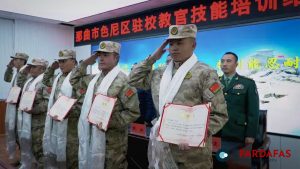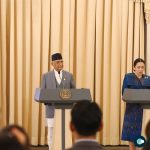
Kenya’s Economic Crisis: The Impact of Chinese Loans and the Strain on National Stability

Kenya, under the leadership of President William Ruto since 2022, is facing an unprecedented economic crisis, marked by widespread protests and social unrest. The core of these protests lies in the government’s attempt to implement drastic tax reforms to manage a staggering national debt, largely owed to China. This report examines the intricate dynamics of Kenya’s economic downturn, highlighting the contentious role of Chinese loans and their profound implications for the country’s future stability.
Ruto’s Economic Policies and Public Backlash:
President William Ruto came to power with promises of economic prosperity and relief for the average Kenyan citizen. However, just seven months into his presidency, signs of economic strain became evident. In April 2023, Ruto’s chief economic adviser starkly highlighted the dire financial situation with a tweet: “Salaries or default? Take your pick.” This ominous message foreshadowed a series of contentious economic decisions that would exacerbate public discontent.
A month later, the government’s decision to withhold paychecks from thousands of civil servants to prioritize foreign loan repayments ignited public outrage. According to an Associated Press report in May 2023, this move was part of a desperate attempt to save cash amid mounting pressure from international creditors, particularly China.
Tax Reforms and Public Outcry:
The catalyst for the widespread protests was the proposed Finance Bill of 2023. This bill included sweeping tax reforms aimed at generating an additional $2.7 billion in domestic revenue. Among the most controversial measures were new levies on digital transactions, a value-added tax (VAT) on bread, and increased excise duties on essential commodities like cooking oil. These proposals sparked fierce opposition from the public, particularly Kenya’s youth, who took to the streets in protest.
The imposition of a 16% VAT on bread and a 25% excise duty on domestically produced cooking oil were seen as particularly burdensome for a population already grappling with high living costs. Additionally, the bill introduced new taxes on income earners enrolled in the national medical insurance plan and annual levies on motor vehicles, further compounding public dissatisfaction.
Debt Crisis and China’s Dominance:
At the heart of Kenya’s economic woes lies its ballooning public debt, which stood at a staggering 11.1 trillion Kenyan shillings ($82 billion) by 2023. A significant portion of this debt is owed to China, a consequence of extensive borrowing under former President Uhuru Kenyatta’s administration, during which Ruto served as vice-president. These loans primarily financed large-scale infrastructure projects, including the construction of the Standard Gauge Railway (SGR) connecting Nairobi to Mombasa, Kenya’s coastal hub.
China has emerged as Kenya’s largest creditor, holding over 70% of the country’s bilateral debts. This dominance has raised concerns about Kenya’s economic sovereignty, as Chinese loan terms are often characterized by lack of transparency and stringent repayment conditions. Critics argue that such conditions prioritize debt servicing over domestic development, exacerbating Kenya’s economic challenges.
Impact on Fiscal Health and Development:
Kenya’s debt servicing costs are alarmingly high, consuming approximately 59% of its total revenues. This leaves limited fiscal space for essential government expenditures, including salaries and social welfare programs. The World Bank estimates that Kenya’s total public debt reached about 68% of its GDP in the fiscal year 2023/24, with projections indicating a marginal decrease to 65% by 2024/25.
The heavy reliance on Chinese loans has further strained Kenya’s economic outlook, with external debt payments projected at 590.6 billion Kenyan shillings ($4.5 billion) for the upcoming fiscal year. This represents a significant drain on Kenya’s foreign currency reserves, essential for servicing international debts and maintaining economic stability.
Transparency Issues and Global Concerns:
Critics of China’s lending practices argue that the lack of transparency in loan agreements poses significant risks to borrower nations like Kenya. Unlike traditional lenders such as the IMF and the World Bank, China does not disclose detailed terms of its loans, leading to uncertainty and potential financial vulnerabilities for borrowing countries. This opacity has been a point of contention among international financial institutions, who advocate for greater transparency and accountability in global lending practices.
Comparative Analysis and Regional Implications:
Kenya’s predicament mirrors similar challenges faced by other countries heavily indebted to China, including Sri Lanka, Pakistan, Zambia, Laos, and Mongolia. These nations have struggled to manage their debt obligations, with a substantial portion of their national revenues allocated to servicing Chinese loans. The Associated Press analysis highlighted that debt repayments to China have increasingly strained foreign currency reserves in these countries, jeopardizing their ability to meet basic economic needs.
Strategic Implications and Policy Shifts:
In response to mounting pressure, President Ruto’s government initially sought additional loans from international financial institutions like the IMF and the World Bank. However, these lenders conditioned further financial assistance on comprehensive economic reforms and improved fiscal transparency. The withdrawal of the Finance Bill in April 2023 underscored the government’s recognition of public discontent and the urgent need for alternative economic strategies.
Moving forward, Kenya faces the daunting task of diversifying its creditor base, reducing dependency on Chinese loans, and implementing sustainable debt management practices. The country’s economic future hinges on its ability to strike a balance between meeting debt obligations and fostering inclusive economic growth that benefits all Kenyan citizens.
Conclusion:
Kenya stands at a critical juncture in its economic trajectory, grappling with the far-reaching consequences of extensive Chinese loans and a burgeoning debt crisis. The path forward necessitates decisive action to enhance fiscal transparency, diversify financial partnerships, and prioritize sustainable development initiatives. As President Ruto navigates these challenges, the international community watches closely, mindful of the broader implications for global financial stability and Kenya’s quest for economic resilience.
- Myanmar Earthquake Death Toll Surpasses 3,300, UN Calls for Global Support
- Prime Minister Oli Returns After Official Visit to Thailand and BIMSTEC Summit Participation
- Resident Doctors at Lumbini Medical College Demand Equal Pay and Reforms
- PM Modi in Sri Lanka to Cement Defence, Energy Ties Amid Regional Power Dynamics












Comments